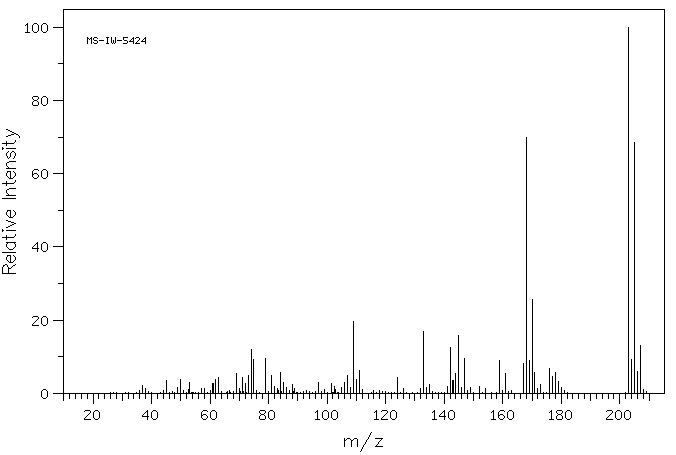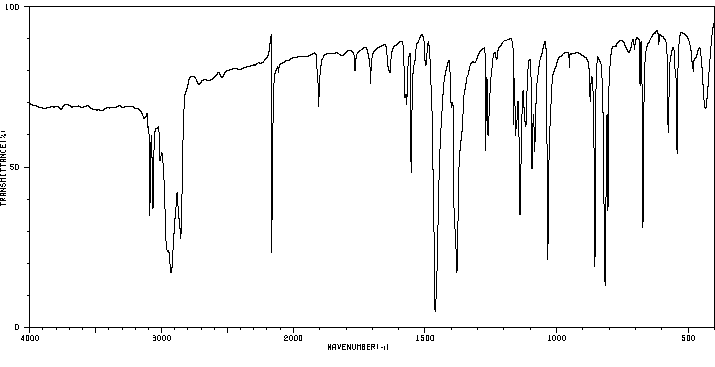1,2-dichloro-4-thiocyanatobenzene | 3313-77-7
中文名称
——
中文别名
——
英文名称
1,2-dichloro-4-thiocyanatobenzene
英文别名
1,2-Dichlor-4-thiocyanatobenzol;3-(3,4-Dichlorphenyl)rhodanin;3,4-Dichlor-phenylthiocyanat;3,4-Dichlorophenyl thiocyanate;(3,4-dichlorophenyl) thiocyanate
CAS
3313-77-7
化学式
C7H3Cl2NS
mdl
——
分子量
204.08
InChiKey
GKTPLPCHBKXVKK-UHFFFAOYSA-N
BEILSTEIN
——
EINECS
——
-
物化性质
-
计算性质
-
ADMET
-
安全信息
-
SDS
-
制备方法与用途
-
上下游信息
-
文献信息
-
表征谱图
-
同类化合物
-
相关功能分类
-
相关结构分类
物化性质
-
熔点:60-61 °C
-
沸点:137-138 °C(Press: 10 Torr)
-
密度:1.49±0.1 g/cm3(Predicted)
计算性质
-
辛醇/水分配系数(LogP):4
-
重原子数:11
-
可旋转键数:1
-
环数:1.0
-
sp3杂化的碳原子比例:0.0
-
拓扑面积:49.1
-
氢给体数:0
-
氢受体数:2
上下游信息
-
上游原料
中文名称 英文名称 CAS号 化学式 分子量 3,4-二氯苯硫酚 3,4-dichlorothiophenol 5858-17-3 C6H4Cl2S 179.07 -
下游产品
中文名称 英文名称 CAS号 化学式 分子量 1-[(三氟甲基)硫代]-3,4-二氯苯 (3,4-dichlorophenyl)(trifluoromethyl)sulfane 458-06-0 C7H3Cl2F3S 247.068
反应信息
-
作为反应物:描述:参考文献:名称:水解von O,O-O-二烷基-S-芳基-硫代磷酸酯摘要:O,O-二烷基-S-芳基-硫代磷酸酯是热不稳定的,并且在约150°的温度下容易分解,形成烷基芳基硫化物和聚合的烷基间-或-聚磷酸盐。在一系列33种硫代磷酸酯中,反应性的差异是根据空间效应和电子效应来合理化的。讨论了热降解的机理,研究了硫醚和苯酚对热分解速率的影响。DOI:10.1016/s0040-4020(01)98339-5
-
作为产物:描述:参考文献:名称:A new synthesis of trifluoromethyl sulfides utilizing thiocyanates and fluoroform摘要:Fluoroform is a potent greenhouse gas which should not be released to the atmosphere. Large amounts of it are stored and wait for new and useful reactions to be based on it. One such general reaction that is described in this paper is its use in preparation of the important organic trifluoromethyl sulfides. Aliphatic, aromatic and heterocyclic thiocyanates are easy to prepare. They were reacted with fluoroform-based CuCF3 to form the corresponding (trifluoromethyl)thio derivatives. (C) 2014 Elsevier B.V. All rights reserved.DOI:10.1016/j.jfluchem.2014.09.026
文献信息
-
COMPOUNDS WITH COPPER- OR ZINC-ACTIVATED TOXICITY AGAINST MICROBIAL INFECTION申请人:Kansas State University Research Foundation公开号:US20220024877A1公开(公告)日:2022-01-27Heterocyclic compounds with a novel pyrazole thioamide-based NNSN structural motif, having highly effective zinc- or copper-activated toxicity against microbial infections at micromolar or nanomolar minimum inhibitory concentrations (MIC), and methods of making and using same.
-
세미카바자이드 유도체 화합물 또는 이의 약학적으로 허용가능한 염을 포함하는 프리온 질환의 예방 또는 치료용 약학적 조성물申请人:한양대학교 에리카산학협력단公开号:KR20230066192A公开(公告)日:2023-05-15본 발명은 세미카바자이드 유도체 또는 이의 약학적으로 허용가능한 염을 유효성분으로 포함하는 프리온 질환의 예방 또는 치료용 약학적 조성물에 관한 것으로, 화학식 1로 표시되는 세미카바자이드 유도체 또는 이의 약학적으로 허용가능한 염은 프리온 단백질의 응집을 억제하는 효과가 탁월하여 프리온 단백질 PrPsc의 응집체가 야기하는 질환의 예방 및 치료용 약물로서 유용하게 사용될 수 있다.
-
Effects of solvation on the nucleophilic reaction of stable carbanions with diaryl disulfides作者:H. F. GilbertDOI:10.1021/ja00543a028日期:1980.11
-
Reaction of Aromatic Thiocyanates with Trialkyl Phosphites作者:Kurt Pilgram、Donald D. PhillipsDOI:10.1021/jo01018a067日期:1965.7
-
[EN] COMPOUNDS WITH COPPER- OR ZINC-ACTIVATED TOXICITY AGAINST MICROBIAL INFECTION<br/>[FR] COMPOSÉS PRÉSENTANT UNE TOXICITÉ ACTIVÉE PAR DU CUIVRE OU DU ZINC CONTRE UNE INFECTION MICROBIENNE申请人:UNIV KANSAS STATE公开号:WO2020061412A1公开(公告)日:2020-03-26Heterocyclic compounds with a novel pyrazole thioamide-based NNSN structural motif, having highly effective zinc- or copper-activated toxicity against microbial infections at micromolar or nanomolar minimum inhibitory concentrations (MIC), and methods of making and using the same.
表征谱图
-
氢谱1HNMR
-
质谱MS
-
碳谱13CNMR
-
红外IR
-
拉曼Raman
-
峰位数据
-
峰位匹配
-
表征信息
同类化合物
(βS)-β-氨基-4-(4-羟基苯氧基)-3,5-二碘苯甲丙醇
(S,S)-邻甲苯基-DIPAMP
(S)-(-)-7'-〔4(S)-(苄基)恶唑-2-基]-7-二(3,5-二-叔丁基苯基)膦基-2,2',3,3'-四氢-1,1-螺二氢茚
(S)-盐酸沙丁胺醇
(S)-3-(叔丁基)-4-(2,6-二甲氧基苯基)-2,3-二氢苯并[d][1,3]氧磷杂环戊二烯
(S)-2,2'-双[双(3,5-三氟甲基苯基)膦基]-4,4',6,6'-四甲氧基联苯
(S)-1-[3,5-双(三氟甲基)苯基]-3-[1-(二甲基氨基)-3-甲基丁烷-2-基]硫脲
(R)富马酸托特罗定
(R)-(-)-盐酸尼古地平
(R)-(-)-4,12-双(二苯基膦基)[2.2]对环芳烷(1,5环辛二烯)铑(I)四氟硼酸盐
(R)-(+)-7-双(3,5-二叔丁基苯基)膦基7''-[((6-甲基吡啶-2-基甲基)氨基]-2,2'',3,3''-四氢-1,1''-螺双茚满
(R)-(+)-7-双(3,5-二叔丁基苯基)膦基7''-[(4-叔丁基吡啶-2-基甲基)氨基]-2,2'',3,3''-四氢-1,1''-螺双茚满
(R)-(+)-7-双(3,5-二叔丁基苯基)膦基7''-[(3-甲基吡啶-2-基甲基)氨基]-2,2'',3,3''-四氢-1,1''-螺双茚满
(R)-(+)-4,7-双(3,5-二-叔丁基苯基)膦基-7“-[(吡啶-2-基甲基)氨基]-2,2”,3,3'-四氢1,1'-螺二茚满
(R)-3-(叔丁基)-4-(2,6-二苯氧基苯基)-2,3-二氢苯并[d][1,3]氧杂磷杂环戊烯
(R)-2-[((二苯基膦基)甲基]吡咯烷
(R)-1-[3,5-双(三氟甲基)苯基]-3-[1-(二甲基氨基)-3-甲基丁烷-2-基]硫脲
(N-(4-甲氧基苯基)-N-甲基-3-(1-哌啶基)丙-2-烯酰胺)
(5-溴-2-羟基苯基)-4-氯苯甲酮
(5-溴-2-氯苯基)(4-羟基苯基)甲酮
(5-氧代-3-苯基-2,5-二氢-1,2,3,4-oxatriazol-3-鎓)
(4S,5R)-4-甲基-5-苯基-1,2,3-氧代噻唑烷-2,2-二氧化物-3-羧酸叔丁酯
(4S,4''S)-2,2''-亚环戊基双[4,5-二氢-4-(苯甲基)恶唑]
(4-溴苯基)-[2-氟-4-[6-[甲基(丙-2-烯基)氨基]己氧基]苯基]甲酮
(4-丁氧基苯甲基)三苯基溴化磷
(3aR,8aR)-(-)-4,4,8,8-四(3,5-二甲基苯基)四氢-2,2-二甲基-6-苯基-1,3-二氧戊环[4,5-e]二恶唑磷
(3aR,6aS)-5-氧代六氢环戊基[c]吡咯-2(1H)-羧酸酯
(2Z)-3-[[(4-氯苯基)氨基]-2-氰基丙烯酸乙酯
(2S,3S,5S)-5-(叔丁氧基甲酰氨基)-2-(N-5-噻唑基-甲氧羰基)氨基-1,6-二苯基-3-羟基己烷
(2S,2''S,3S,3''S)-3,3''-二叔丁基-4,4''-双(2,6-二甲氧基苯基)-2,2'',3,3''-四氢-2,2''-联苯并[d][1,3]氧杂磷杂戊环
(2S)-(-)-2-{[[[[3,5-双(氟代甲基)苯基]氨基]硫代甲基]氨基}-N-(二苯基甲基)-N,3,3-三甲基丁酰胺
(2S)-2-[[[[[((1S,2S)-2-氨基环己基]氨基]硫代甲基]氨基]-N-(二苯甲基)-N,3,3-三甲基丁酰胺
(2S)-2-[[[[[[((1R,2R)-2-氨基环己基]氨基]硫代甲基]氨基]-N-(二苯甲基)-N,3,3-三甲基丁酰胺
(2-硝基苯基)磷酸三酰胺
(2,6-二氯苯基)乙酰氯
(2,3-二甲氧基-5-甲基苯基)硼酸
(1S,2S,3S,5S)-5-叠氮基-3-(苯基甲氧基)-2-[(苯基甲氧基)甲基]环戊醇
(1S,2S,3R,5R)-2-(苄氧基)甲基-6-氧杂双环[3.1.0]己-3-醇
(1-(4-氟苯基)环丙基)甲胺盐酸盐
(1-(3-溴苯基)环丁基)甲胺盐酸盐
(1-(2-氯苯基)环丁基)甲胺盐酸盐
(1-(2-氟苯基)环丙基)甲胺盐酸盐
(1-(2,6-二氟苯基)环丙基)甲胺盐酸盐
(-)-去甲基西布曲明
龙蒿油
龙胆酸钠
龙胆酸叔丁酯
龙胆酸
龙胆紫-d6
龙胆紫








